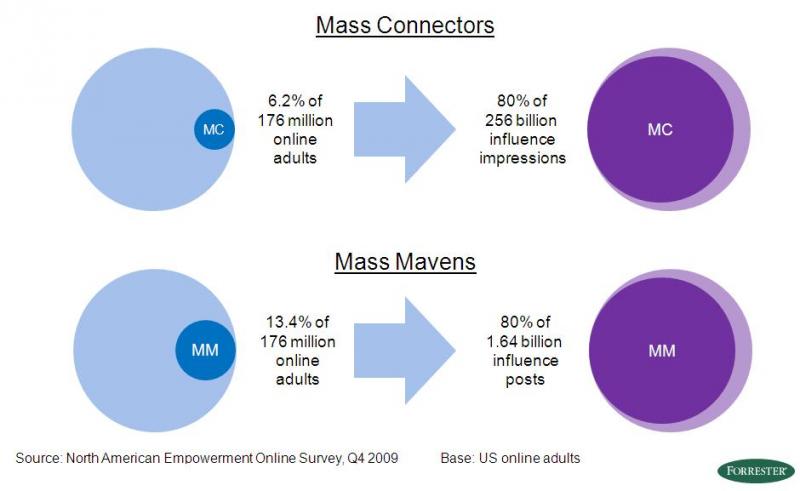Peer Influence Analysis: What It Is & How Marketers Use It
Recently, Forrester introduced a new way to consider influence in Social Media. We identified a group of social media participants we call Mass Influencers. While just 16% of the US population, Mass Influencers are responsible for 80% of the influence impressions and posts about products and services in social channels.

As noted in the Forrester report, Tapping The Entire Online Peer Influence Pyramid and on the Forrester blog, Mass Influencers come in two flavors:
- Mass Connectors, who create a great number of impressions about brands and services in social networks, like Twitter and Facebook, and
- Mass Mavens, who create and share content about products and services in other social channels such as YouTube, blogs, forums, or ratings and review sites.
The fact that a minority of social media participants represent the lion’s share of buzz about products and services is probably not at all surprising, but what does this mean to marketers? How can brands develop programs that activate the potential of Mass Influencers to create awareness and consideration among their readers, friends, followers and others in social venues? The answer comes from Peer Influence Analysis (PIA), Forrester’s new framework to analyze influence within particular markets, demographics and industries.
Josh Bernoff and I collaborated on a new report, Peer Influence Analysis, that demonstrates how PIA can be applied to the needs of a brand. In our report, we applied very real data for a hypothetical HDTV brand. Using PIA, we can identify characteristics of Mass Influencers who share news and opinions about consumer electronics products. For example:
-
Consumer Electronics Mass Influencers are younger, more affluent and more likely to be male than the average US online participant. This information can be used to target advertising and PR that is more likely to reach the right kind of Mass Influencer for this brand.
-
Twitter is an important tool for the Consumer Electronics Mass Connector. Compared to the general US online population, they are four times more likely to read others’ tweets and five times more likely to have a Twitter account and almost ten times more likely to ask for the opinions of their Twitter friends before making a large purchase. This data can help drive Twitter strategies, such as a social loyalty program that rewards owners of the HDTV for tweeting what they are watching along with a branded hashtag.
- The offline influence of the Consumer Electronics Mass Maven is considerable. They are 133% more likely to say that friends and family always or often seek their opinion before making a purchase than the typical US online adult. This data can generate ideas for sparking the Analog Groundswell, such as house parties where owners of this HDTV brand can welcome friends to test out their TVs. The brand can sponsor these parties by offering promotional items or contests for participants and hosts.
Other data that PIA furnished for our HDTV brand included information about mobile use, most popular research sources before making a decision, social network preference, and other data that can help guide Word of Mouth marketing strategies. By using PIA, marketers can be sure they’re not squandering marketing dollars by using strategies or channels that reach the average Consumer Electronics consumer but miss the potent Consumer Electronics Mass Influencers.
PIA is a powerful new framework that takes theories of influence and makes it actionable. I look forward to working with clients to explore their Mass Influencers in the future. If you're a marketer who wishes to understand the Mass Influencers in your market, I'm sure it goes without saying that we'd welcome a discussion about what Peer Influence Analysis can do to help further your social media marketing strategies.
![Reblog this post [with Zemanta]](http://img.zemanta.com/reblog_e.png?x-id=425b4dda-23c0-462d-a58b-8c846af069fb)